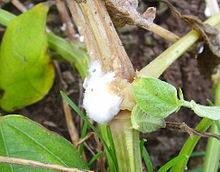Sclerotinia sclerotiorum
| Sclerotinia sclerotiorum | |
|---|---|
 |
|
| Sclerotinia sclerotiorum on Phaseolus | |
| Scientific classification | |
| Kingdom: | Fungi |
| Division: | Ascomycota |
| Class: | Leotiomycetes |
| Order: | Helotiales |
| Family: | Sclerotiniaceae |
| Genus: | Sclerotinia |
| Species: | S. sclerotiorum |
| Binomial name | |
|
Sclerotinia sclerotiorum (Lib.) de Bary (1884) |
|
| Synonyms | |
|
|
Sclerotinia sclerotiorum is a plant pathogenic fungus and can cause a disease called white mold if conditions are correct. S. sclerotiorum can also be known as cottony rot, watery soft rot, stem rot, drop, crown rot and blossom blight. A key characteristic of this pathogen is its ability to produce black resting structures known as sclerotia and white fuzzy growths of mycelium on the plant it infects. These sclerotia give rise to a fruiting body in the spring that produces spores in a sac which is why fungi in this class are called sac fungi (Ascomycetes). This pathogen can occur on many continents and has a wide host range of plants. When S. sclerotiorum is onset in the field by favorable environmental conditions, losses can be great and control measures should be considered.
Common hosts of white mold are herbaceous, succulent plants, particularly flowers and vegetables. It can also affect woody ornamentals occasionally, usually on juvenile tissue. White mold can affect their hosts at any stage of growth, including seedlings, mature plants, and harvested products. It can usually be found on tissues with high water content and in close proximity to the soil. One of the first symptoms noticed is an obvious area of white, fluffy mycelial growth. Usually this is preceded by pale to dark brown lesions on the stem at the soil line. The mycelium then cover this necrotic area. Once the xylem is affected, other symptoms occur higher up in the plant. These can include chlorosis, wilting, leaf drop, and death quickly follows. On fruits, the initial dark lesions occur on the tissue that comes in contact with the soil. Next, white fungal mycelium covers the fruit and it decays. This can occur when the fruit is in the field or when in storage.
White mold affects a wide range of hosts. It is known to infect 408 plant species. Its diverse host range and ability to infect plants at any stage of growth makes white mold a very serious disease. The fungus can survive on infected tissues, in the soil, and on living plants. It affects young seedlings, mature plants, and fruit in the field or in storage. White mold can spread quickly in the field from plant to plant. It can also spread in a storage facility throughout the harvested crop. Some crops it affects commonly are soybeans, green beans, sunflowers, canola, and peanuts.
...
Wikipedia

